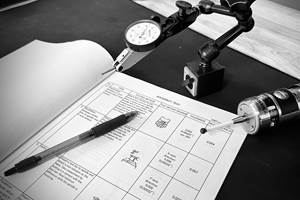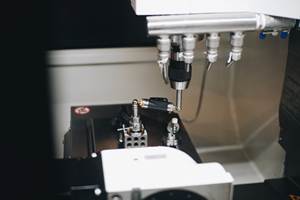Common Methods for Measuring Workpiece Radii
With today’s complicated and very high-precision parts, workpiece radii can have a variety of shapes and contours. Sophisticated tools can help simplify the measurement process.
Share





Measuring radii on workpieces is a common inspection task in industrial production. Radii occur in very different contour shapes. A radius can merge into another radius or a straight line; the transition can be smooth (that is, tangential) or end in an edge, angle or any linear contour.
For large parts or for noncritical applications, measuring the radius on a part is one of those checks that can be done in one of two ways — one that “looks good enough for me” to one that can be measured to microns. Most think of a radius as the conjunction of two surfaces meeting 90 degrees to one another. On larger parts, a depth gage with a 90-degree fixture can make the qualification. A more subjective check will be a set of radius gages and a skilled operator trying to determine the best match.
However, with today’s more complicated and very high-precision parts, workpiece radii can have a variety of shapes and contours. Measuring them is part of daily business in production, and many highly sophisticated tools considerably simplify the measurement of complicated workpieces. A specialized measuring method is required to calculate radii with tangentially connected contour geometries and the transition points of the neighboring contour elements.
On most complicated parts, the transition to the radius is not 90 degrees, so one must be able to measure the lines on the front and back sides of the radius to begin the process. These measurements are ideal for contour systems that can run a trace from the starting line, through the radius and then over the exiting line. A contour system is a growing extension of surface roughness machines, but with more range to perform these profile measurements. However, there are other times when the part lends itself to the application of using vision, such as in a shaft machine or measuring microscope, where the same techniques can be used to precisely calculate the radius.
All these systems calculate the tangential circle that transitions into two straight lines. With the measuring system, once the trace is made, the operator can view the profile of the part. Most contour and vision systems can do all types of calculations based on data from the profile in front of them. In this case, the operator would select the two regression lines leading to the radius. A common method used with these lines is calculating the angle between the two selected lines. However, in this case, the system will have a choice to calculate the “tangential circle to the straight lines.”
Based on the intersection of the two straight lines, a tangential circle is created and, if needed, the circle can be displayed as a full circle. It is also possible to filter the profile in the area of the circular arc in order to eliminate roughness components. The tangential circle is fitted in such a way that the sum of the distance squares of the measured profile points in the selected circle segment is minimal, taking into account the transition points of the tangential straight lines. With the circle in place, the measuring system can precisely calculate the radius of the two intersecting lines. Even for contour profiles with high roughness and small circle segments, the tangential functions work reliably and robustly so that the repeatability of the results is extremely high.
Many systems will also be able to calculate the tangential circle with only one straight line — in this case, the tangential point between the circle and the straight line is formed on one side. With this method, the operator would select the leading line coming into the radius and then limit the circle and the remaining profile. The circle and radius are still available for reporting.
There probably is no better or higher-precision way to make these types of radii or transition checks than with a profiling contour system or vision system designed for this purpose. The ability to use the collected data points and analyze them easily makes the check much more straightforward for the operator and requires no guesswork.
Related Content
4 Ways to Establish Machine Accuracy
Understanding all the things that contribute to a machine’s full potential accuracy will inform what to prioritize when fine-tuning the machine.
Read MoreBallbar Testing Benefits Low-Volume Manufacturing
Thanks to ballbar testing with a Renishaw QC20-W, the Autodesk Technology Centers now have more confidence in their machine tools.
Read MoreHow to Evaluate Measurement Uncertainty
Manufacturing and measurement are closely coupled. An important consideration for the use of measurement results is the associated measurement uncertainty. This article describes common metrology terms and provides an example uncertainty analysis.
Read MoreOrthopedic Event Discusses Manufacturing Strategies
At the seminar, representatives from multiple companies discussed strategies for making orthopedic devices accurately and efficiently.
Read MoreRead Next
Machine Shop MBA
Making Chips and 91±¬ÁĎÍř are teaming up for a new podcast series called Machine Shop MBA—designed to help manufacturers measure their success against the industry’s best. Through the lens of the 91±¬ÁĎÍř benchmarking program, the series explores the KPIs that set high-performing shops apart, from machine utilization and first-pass yield to employee engagement and revenue per employee.
Read MoreAMRs Are Moving Into Manufacturing: 4 Considerations for Implementation
AMRs can provide a flexible, easy-to-use automation platform so long as manufacturers choose a suitable task and prepare their facilities.
Read More





















